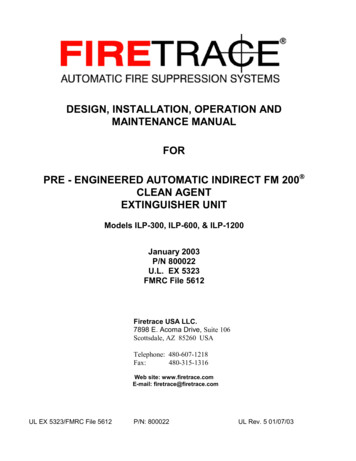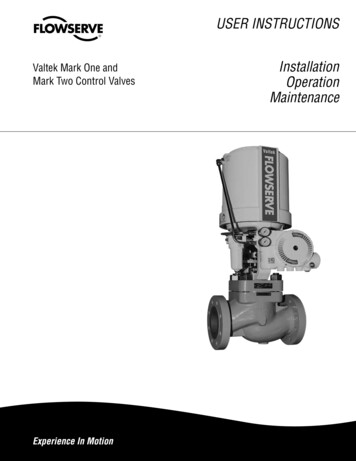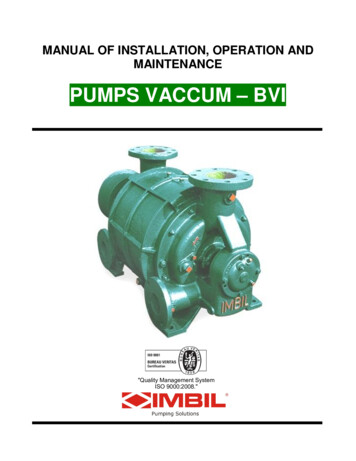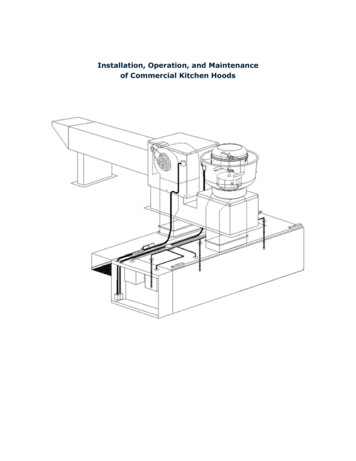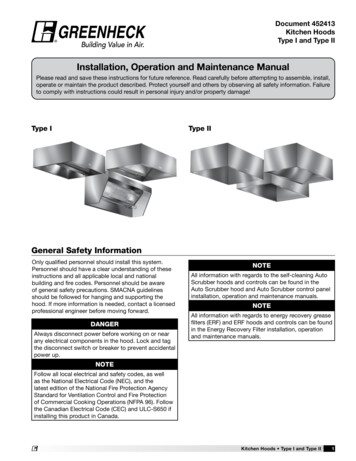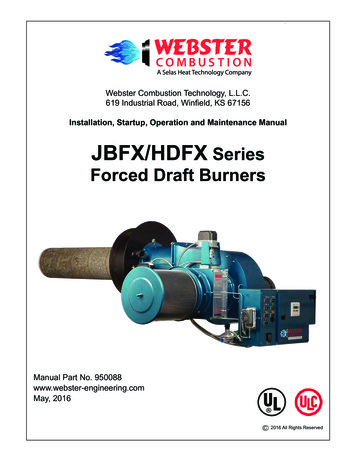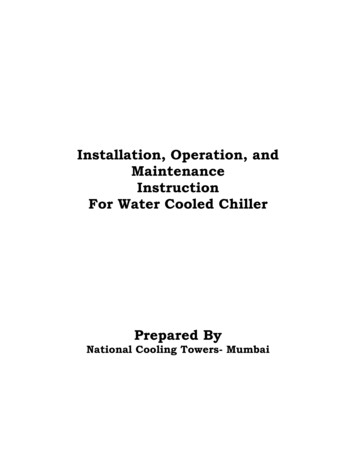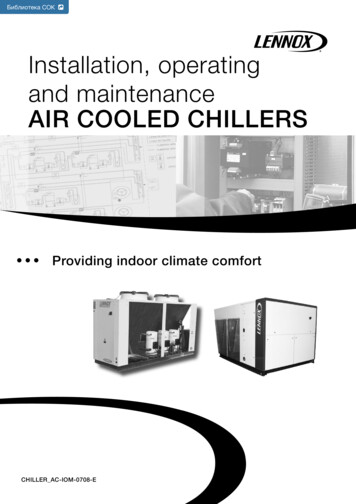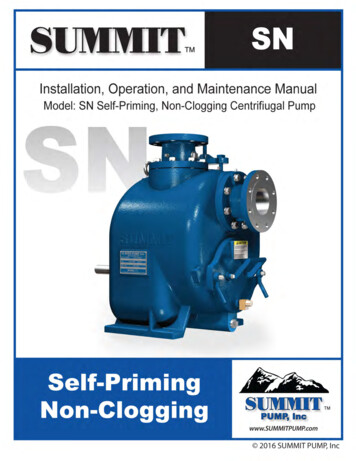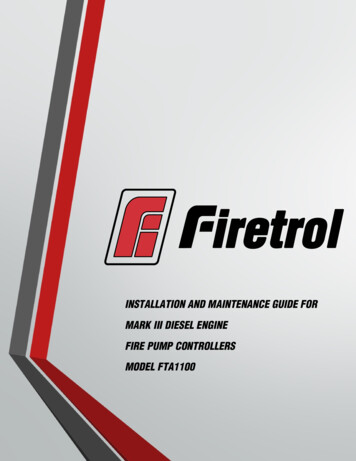
Transcription
INSTALLATION AND MAINTENANCE GUIDE FORMARK III DIESEL ENGINEFIRE PUMP CONTROLLERSMODEL FTA11001
FTDiesel Manual v2.2.0.0 (CDL)IntroductionThese instructions are intended to assist in the understanding of the installation and operation of the FTA1100. Readthrough these instructions thoroughly prior to connecting the controller. If there are any questions unanswered in theseinstructions, please contact the local Firetrol representative or factory service department.Types of Diesel Engine Fire Pump ControllersFIRE PUMP CATALOG NUMBERMODEL No. EXAMPLE: FTA1100-JL12NModel: FTA1100-JBattery Type: L LeadAcid, N Ni-CadBattery Voltage: 12 12v, 24 24vIncoming Voltage: Standard 110/120V 50/60Hz, Option -BA 208/240V 50/60HzMethods of Starting/StoppingMETHODS OF STARTINGAUTOMATIC STARTThe controller will start automatically on low pressure detection by the pressure sensor when the pressure drops below thecut-in threshold.MANUAL STARTThe engine can be started by pressing the CRANK 1 or and/or CRANK 2 push button, regardless of the system pressure, whenthe Main Selector switch is in the HAND position. The Fuel Solenoid Valve will open as soon as a CRANK button is pressedand will remain in this state.REMOTE MANUAL STARTThe engine can be started from a remote location by momentarily closing a contact of a manual push button.REMOTE AUTOMATIC START, DELUGE VALVE STARTThe engine can be started from a remote location by momentarily opening a contact connected to an automatic device. Thecontroller must be in automatic mode.SEQUENTIAL STARTIn case of a multiple pump application, it may be necessary to delay the starting of each motor when there is a waterpressure drop to prevent simultaneous starting of all motors.FLOW START, HIGH ZONE STARTThe pump can be started by opening/closing a contact on the FLOW/ZONE START/STOP input.WEEKLY STARTThe engine can be started (and stopped) automatically at the preprogrammed time.TEST STARTThe motor can be started manually by pressing the run test button.METHODS OF STOPPING2
MANUAL STOPManual stop is done by pressing the STOP push button. Note that pressing the stop push button will stop the engine only ifall starting causes have disappeared.AUTOMATIC STOPThe automatic stop is possible only after an automatic start and this function has been activated. When this function isEnabled, the motor is automatically stopped 30 minutes (adjustable) after the restoration of the pressure (above the cut-outthreshold) given that no other run cause is present.FLOW STOP, HIGH ZONE STOPIf the controller has been started by the FLOW/ZONE START/STOP input and the signal has returned to normal, the motor willbe stopped given that no other run cause is present.EMERGENCY STOPThe emergency stop is always possible in any running condition and is done by positioning the main selector switch to theOFF position.InstallationFiretrol FTA1100 combined automatic and manual diesel engine fire pump controllers are intended for starting andmonitoring fire pump diesel engines. They are available for use with 12 or 24 volt negative ground systems using lead acidor Nickel-Cadmium batteries. FTA1100 fire pump controllers are listed by Underwriters Laboratories Inc., in accordance withUL218, Standard for Fire Pump Control-lers, CSA, Standard for Industrial Control Equipment (cUL), and approved by FactoryMutual. They are built to meet or exceed the requirements of the approving authorities as well as NEMA and the latesteditions of NFPA 20, Installation of Centrifugal Fire Pumps, and NFPA 70, National Electrical Code.Except in some cases, the controller is also seismic approved and has been tested in accordance with the ICC-ES AC156, IBC2015 & CBC 2016 standards. Proper installation, anchoring and mounting is required to validate this compliance report.Refer to this manual and drawings to determine the seismic mounting requirements and location of the center of gravity (youmay need to contact factory). The equipment manufacturer is not responsible for the specification and performance ofanchorage systems. The structural engineer of record on the project shall be responsible for anchorage details. Theequipment installation contractor shall be responsible for ensuring the requirements specified by the structural engineer ofrecord are satisfied. If detailed seismic installation calculations are required, please contact the manufacturer for theperformance of this work.FCC Regulations and Radio Standards Specification (RSS) RulesTo comply with FCC and Industry Canada RF exposure compliance requirements, a separation distance of at least 20 cm mustbe maintained between the antenna of this device and all nearby persons. This device must not be co-located or operating inconjunction with any other antenna or transmitter.This device complies with Industry Canada licence-exempt RSS standard(s). Operation is subject to the following twoconditions: (1) this device may not cause interference, and (2) this device must accept any interference, includinginterference that may cause undesired operation of the device.This device complies with part 15 of the FCC Rules. Operation is subject to the following two conditions: (1) This device maynot cause harmful interference, and (2) this device must accept any interference received, including interference that maycause undesired operation.Note: This equipment has been tested and found to comply with the limits for a Class A digital device, pursuant to part 15 ofthe FCC Rules. These limits are designed to provide reasonable protection against harmful interference when the equipmentis operated in a commercial environment. This equipment generates, uses, and can radiate radio frequency energy and, ifnot installed and used in accordance with the instruction manual, may cause harmful interference to radio communications.Operation of this equipment in a residential area is likely to cause harmful interference in which case the user will berequired to correct the interference at his own expense.3
“Changes or modifications not expressly approved by the party responsible for compliance could void the user's authority tooperate the equipment.”LocationThe controller shall be located as close as practical to the engine/motor it controls and shall be within sight of theengine/motor. The controller shall be located or protected such that it will not be damaged by water escaping from pump orpump connections. Current carrying parts of the controller shall be not less than 12 in. (305 mm) above the floor level.Working clearances around controller shall comply with NFPA 70, National Electrical Code, Article 110 or C22.1 or otherlocal codes.The controller is suitable for use in locations subject to a moderate degree of moisture, such as a damp basement. The pumproom ambient temperature shall be between 39 F (4 C) and 104 F (40 C) (If a temperature option is included, see the ratinglabel for maximum temperature).The standard controller enclosure is rated NEMA 2. It is the installer's responsibility to insure that either the standardenclosure meets the ambient conditions or that an enclosure with an appropriate rating has been provided. Controllers mustbe installed inside a building and they are not designed for outside environment. The paint color may change if thecontroller is exposed to ultraviolet rays for a long period of time.MountingThe fire pump controller shall be mounted in a substantial manner on a single incombustible supporting structure. Wallmounted controllers shall be attached to the structure or wall using all four (4) mounting ears provided on the controller withhardware designed to support the weight of the controller at a height not less than 12 in. (305 mm) above floor level. Floormounted controllers shall be attached to the floor using all holes provided on the mounting feet with hardware designed tosupport the weight of the controller. The mounting feet provide the necessary 12 in. (305 mm) clearance for current carryingparts. For seismic applications, the mounting arrangement should be rigid wall and base only. The structural engineer ofrecord on the project shall be responsible for anchorage details.Note—Consult the appropriate job plans to determine controller mounting location. Controller must be mounted within viewof the engine.Tools and Materials (all mounting):1.2.3.4.5.6.Assortment of common hand tools of the type used to service electromechanical equipment.Hole (conduit) punch.Drill for drilling wall/floor anchor holes.Hand level.Tape measure.Four (4) anchors with bolts and washer—if wall mount. Six (6) anchors, bolts and washers—if floor/base mount.Wall Mount— Procedure1.Locate bottom mounting brackets and hardware.2.Inspect for damage.3.Gently lay the controller on its back, using protection so the paint is not damaged. It is best to lay the controller ina location that is out of the way from actual mounting location.4.Attach each bracket to the bottom of the enclosure using the supplied hardware . Tighten nuts securely.Note—Refer to the controller dimension drawing for necessary mounting dimensions.The controller is wall mounted by using four (4) wall anchors, 2 anchors for the top ears and 2 anchors for the bottommounting brackets. The ears and brackets are dimensionally on the same center-line for ease in mounting.4
5.Using either the dimension print or by measuring the distance between the center lines of the 2 lower bracket slots,transcribe this dimension onto the wall. Note: The bottom edge of the en-closure should be a minimum of 12” (305 mm.) fromthe floor in case flooding of the pump room occurs.6.Drill and put 2 anchors into the wall for the 2 lower bracket slot mounts.7.Mark on the wall, the location of the holes in the upper mounting ears.8.Drill and put 2 anchors into wall for the upper mounts.9.Install bolts and washers in 2 lower anchors, leaving a gap between the washer and wall.10.Lift the controller and place the bottom mounting slots down onto the 2 lower anchor bolts. Do not tighten bolts.11.Align holes in upper mounting ears and install 2 bolts and washers in anchors.12.Shim anchors as necessary to ensure rear of enclosure is vertically level and enclosure is not stressed. Tighten all4 anchor bolts.13.Check to be sure enclosure door opens and closes freely and that enclosure is level.Floor/Base Plate Mount—Procedure–MOUNTING LEGS (OPTIONAL - IF ORDERED) Procedure—1.Unpack legs and mounting hardware.2.Inspect legs for damage.3.Gently lay the controller on its back, using protection so the paint is not damaged. It is best to lay the controller ina location that is out of the way from actual mounting location.4.Attach each leg to the bottom of the enclosure using the provided hardware . Tighten nuts se-curely.5.After legs are securely attached, stand the controller up on its legs for mounting. Each leg has 3 holes on thebottom for anchoring to the floor or base plate.Note—Consult the appropriate job plans to determine controller mounting location.Refer to the controller dimension print for necessary mounting dimensions.The controller is floor/base plate mounted by using the 3 pre-drilled holes in each leg. The holes are dimensionally on thesame center line for ease in mounting.6.Using either the dimension print or by measuring distance between the center lines of the holes on one leg,transcribe these dimensions onto the floor/base plate.7.Drill 3 holes in floor/base plate for anchoring the leg.8.Mark location of holes for opposite leg and drill 3 more holes.9.Secure controller to floor/base plate with bolts and washers and tighten.10.Check to be sure enclosure door opens freely and that enclosure is level.StorageIf the controller is not installed and energized immediately, Firetrol recommend following the instructions from the chapter 3of the NEMA ICS 15 standard.Wiring and ConnectionsWater ConnectionsThe controller must be connected to the pipe system according to the latest edition of NFPA20 and also to a drain pipe. Thewater connections are on the left side of the controller. The connection to the system pressure is a Male ½ NPT. If a drainis present, the connection to the drain is a tapered connection for plastic tubing.Electrical WiringThe electrical wiring between the power source and the diesel engine fire pump controller shall meet the NFPA 20, Chapter12.3.5.1, 12.3.5.2 and 12.2.5.3, NFPA 70 National Electrical Code Article 695 or C22.1 Canadian Electrical Code, Section 32200 or other local codes.5
Use #14 AWG wire minimum for all electrical connections except for battery charger connec-tions. (Battery chargersconnected to terminals 6, 8, and 11.) On terminals 6, 8, and 11, use the following information to determine wire sizes:Linear feet (in conduit run) from controller to terminal blockon engine0’ to 25’ (0 to 7.62 m.)25’ to 50’ (7.62 m. to 15.24 m.)Maximum Wire Size#10 AWG (6 mm2)#8 AWG (10 mm2)Electrical ConnectionsImportant Precautions—Prior to making any field connections:1. Open door of enclosure and inspect internal components and wiring for any signs of frayed or loose wires or othervisible damage.2. Verify that the controller information is what is required on the project:Firetrol catalog numberEngine voltage and polarity of groundingIncoming line voltage and frequencyMaximum system pressure3.Project electrical contractor must supply all necessary wiring for field connections in accordance with the NationalElectrical Code, local electrical code and any other authority having jurisdic-tion.4.Refer to the appropriate field connection drawing for wiring information.The installer is responsible for adequate protection of the fire pump controller components against metallic debris or drillingchips. Failure to do so may cause injuries to personnel, damage the controller and subsequently void warranty.Energy ConsumptionDiesel Controller with boost chargerModel / State12VDC / @No charge12VDC / @Full charge*24VDC / @No charge24VDC / @Full charge**120VAC220/240V
Firetrol FTA1100 combined automatic and manual diesel engine fire pump controllers are intended for starting and monitoring fire pump diesel engines. They are available for use with 12 or 24 volt negative ground systems using lead acid or Nickel-Cadmium batteries. FTA1100 fire pump controllers are listed by Underwriters Laboratories Inc., in accordance with

